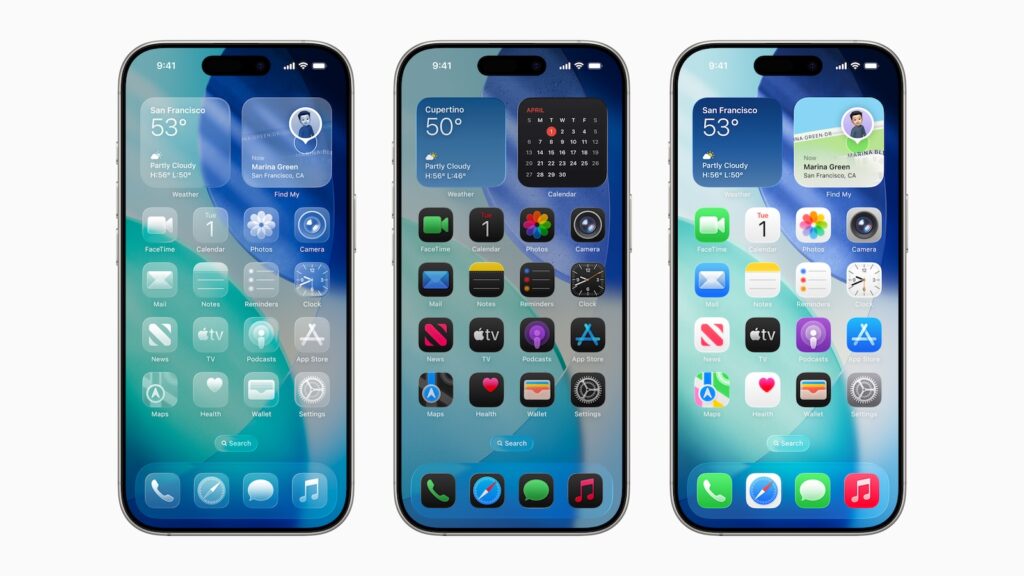With iOS 26, Apple introduced several visible changes to the iPhone's home screen. The focus is on the new Liquid Glass design, which immediately catches the eye. But there have also been some changes to icon options, widgets, the Control Center, and web app integration. If you're wondering what's actually changing in everyday life, you'll find a detailed overview here.
Apple hasn't reinvented the wheel in iOS 26, but it has reworked many details on the home screen, which, when combined, create a significantly more modern feel. The focus is primarily on design, transparency, new customization options, and an overall more personalized user experience. While much of the functionality remains the same, it looks and, in some cases, feels different.
Liquid Glass design
The biggest change to the home screen is the new Liquid Glass design. App icons appear layered and slightly transparent, almost as if they were made up of multiple panes of glass. The effect is subtle but clearly visible. Apple has applied this look to many of its own apps, including Safari, Photos, Maps, Mail, and the App Store. Third-party apps also adopt the new look if their icon design matches it. Apps with simple icons and solid backgrounds benefit automatically without any special adjustments. The Dock is now transparent and blends in with the wallpaper. The same applies to the Search button. Folders have a matte glass design that adapts to the wallpaper used. As soon as you edit the home screen, the editing buttons also become transparent. An additional lighting effect ensures that the appearance changes slightly when you move the iPhone. This makes the Dock, folders, and search bar appear like real glass.
Light, dark and tinted mode
The new design works equally well in both light and dark modes. The app icons retain their glass appearance, and the background adapts accordingly. Apple has replaced the “Light Mode” label in the settings with “Standard Mode.” There are now new options called “Always” and “Auto” that let you specify whether your iPhone switches modes permanently or based on the time of day. The buttons for changing the icon size (“Small” and “Large”) have been moved to the top right corner of the customization interface. In tinted mode, the icons look different than in previous versions like iOS 18. Instead of a black background and colored graphics, the icons in light mode have a solid background color with white graphics. In dark mode, the color is retained but appears significantly darker—without being completely black. Here, too, the glass look is retained, but less noticeable.

Clear symbols
The "Transparent Icons" setting is new. It emphasizes the Liquid Glass style even more. The app icons become almost completely transparent and take on the color of the selected background image. The text remains white. You can choose between a light and a dark look. In light mode, it looks like frosted glass, while in dark mode, it looks like tinted glass. This setting changes the home screen significantly more than the other options and creates a particularly minimalist appearance.
widgets
Widgets have been adapted to the new look, at least partially. In default mode, they look largely the same as in iOS 18. With the "Transparent" option enabled, they adapt their color to the background image and appear as part of the overall image. Here, too, the transparency is noticeable, albeit less pronounced than with the app icons.
Background image editing
In iOS 26, you can edit your wallpaper directly from the home screen. To do so, long-press the screen and then tap "Edit Wallpaper." You can:
- change the background image
- select a gradient
- adjust the color
- select a photo
- activate or deactivate the blur
Important: Changes to the wallpaper only affect the home screen, not the lock screen. The wallpaper plays a more significant role than before, as it affects the appearance of the dock, folders, and icons—especially in tinted and transparent modes.
control center
The Control Center has been redesigned, but remains functionally the same. The new icons appear more three-dimensional and have more depth thanks to the Liquid Glass effect. Some buttons have been visually adjusted, such as volume and brightness – they are now rounder and larger. The icons look like they are made of frosted glass, matching the rest of the design.
Further changes to the home screen
Some other areas have also been visually adjusted:
- The Dynamic Island remains unchanged in function, but looks more modern
- The notification center has been unified in style
- Long press gestures work as before
- The app library now has translucent folders
- The icons in the app library are larger and closer together
- The app library search bar is now rounded
Widgets within the app library also adapt to the selected icon color and glass look.
Web apps
One important change concerns the behavior of websites you add to the Home screen. In iOS 26, every added website automatically opens as a web app—even if the developer wasn't specifically prepared as a web app. If you prefer a website to open in Safari, you can deselect the "Open as Web App" option when adding it to the Home screen.
More than just looks: What iOS 26 really changes
iOS 26 brings many visible changes to the iPhone's home screen that, at first glance, seem purely design-related, but are noticeable in everyday use. The new Liquid Glass design, the clear icons, and the improved customization options make your iPhone more personal and modern. Transparency effects, new editing options, and the updated Control Center round out the update. If the look of your home screen is important to you, iOS 26 offers a host of new possibilities – without sacrificing functionality. Looking for new accessories? Visit our Amazon Storefront – there you'll find a variety of products from leading manufacturers, including HomeKit and more! (Image: Apple)
- iOS 26: All the new features around the Liquid Glass design
- iOS 26: 7 exciting AirPods features at a glance
- iOS 26: Everything you need to know about the new FaceTime features
- Genmoji in iOS 26: Apple gives the feature a major update
- iOS 26: Everything about the new games app for iPhone, iPad, and Mac
- iOS 26: The most important new features in the Photos app
- iOS 26: Beats and AirPods automatically pause when you sleep
- iOS 26: All Apple Music innovations at a glance
- iOS 26 expands the functionality of the HomePod
- Image Playground gets significantly better with iOS 26
- iOS 26 brings new screenshot features to the iPhone
- iOS 26: Five new lock screen features at a glance
- iOS 26 design change: Reduce transparency easily
- iOS 26: Create your own ringtones – without GarageBand
- iOS 26: All the new features for Notes and Reminders
- Apple's new Siri could be worth the wait
iOS 26: Frequently asked questions about the new iPhone home screen
iOS 26 introduces the new Liquid Glass design, where app icons appear layered and transparent. The Dock, folders, and search bar have also been redesigned and are now transparent with dynamic lighting effects.
Liquid Glass is a new look for app icons in iOS 26. Icons look like stacked layers of glass, have depth, and visually adapt to the background.
In iOS 26, you can choose between Standard, Dark, Tinted, and Transparent. Each option changes the color, transparency, and appearance of the app icons.
Transparent mode makes app icons almost completely transparent. They take on the color of the background and display only white text and graphics.
Press and hold the home screen and select "Edit Wallpaper." You can customize colors, photos, gradients, and blur—independently of the lock screen.
The Control Center remains functionally the same, but has been visually redesigned. Icons are now larger, rounder, and have a frosted glass finish.
Yes, widgets adapt to the selected icon mode. In Clear mode, they are transparent and blend seamlessly into the background image.
Websites you add to the home screen will automatically open as standalone web apps, regardless of their configuration. However, you can disable this when adding them.
No, the changes mainly affect the design, display, and customization options. The basic functionality remains the same.
No, you can initiate the update manually. However, it's recommended for all compatible iPhones, as iOS 26 also includes security updates.





